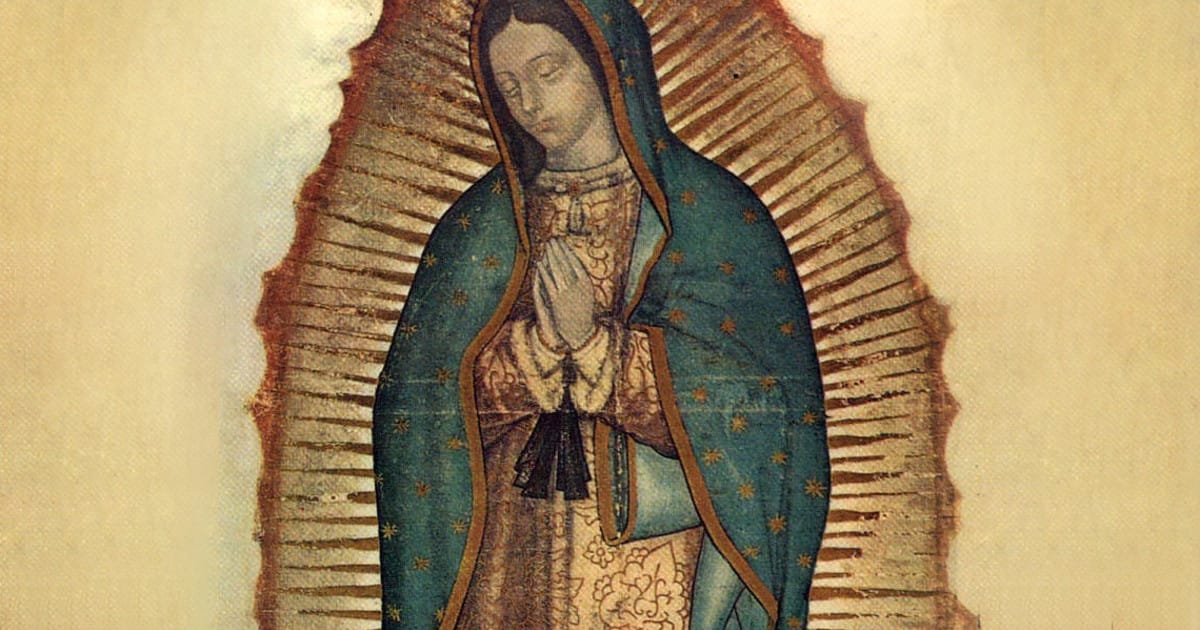Get ready to delve into the captivating mysteries surrounding Our Lady of Guadalupe, a venerated religious image that has captivated hearts and confounded scientific minds for centuries. Join us as we explore the inexplicable phenomena associated with this iconic image, delving into a world where faith and science intertwine.
Our Lady of Guadalupe: Scientific Facts
The image of Our Lady of Guadalupe, said to have been miraculously imprinted on Juan Diego’s tilma (a simple cloak), has intrigued scientists for generations. It’s a captivating fusion of religious belief and scientific anomalies.
The Tilma: Tougher Than It Looks
Let’s start with the tilma itself. Crafted from agave fibers, a material known for its relatively short lifespan, the tilma’s durability is the first clue that something extraordinary might be at play. While similar agave-based fabrics typically degrade within a few decades, the tilma has defied time and the elements for nearly 500 years, remaining remarkably intact.
Celestial Map or Happy Coincidence?
Adding to the intrigue are the stars adorning Our Lady’s cloak. Some researchers suggest that these stars align with the constellations visible in Mexico City in December 1531, the same time period when Juan Diego is said to have encountered the Virgin Mary. Could this be a celestial snapshot woven into the very fabric of the tilma, or merely a coincidental arrangement?
And what about those flowers near her feet? They bear a striking resemblance to Castilian roses, a variety not found in Mexico during that era. Was this a subtle nod to Our Lady’s European roots, or simply an artistic choice that coincidentally mirrored a flower from another continent? The question remains open for debate.
Eyes That Seem Alive
Perhaps the most startling discovery lies within Our Lady’s eyes. Scientists, upon closer inspection, observed a phenomenon known as the Samson-Purkinje effect – a subtle change in pupil size in response to varying light intensities. This effect, typically observed in living beings, has been documented in the tilma’s eyes, leading some to ponder if the image captured a flicker of life itself.
A Cultural Phenomenon and a Scientific Enigma
Beyond its scientific peculiarities, the image of Our Lady of Guadalupe holds immense cultural and religious weight. She is a beacon of hope, particularly for the indigenous people of Mexico, as her image played a pivotal role in the widespread conversion to Catholicism. The Basilica built in her honor in Mexico City stands as a testament to her enduring legacy, attracting millions of pilgrims each year – a testament to the profound impact her story continues to have.
More Questions Than Answers
Despite rigorous scientific analysis, the image of Our Lady of Guadalupe remains an enigma. The source of the image, the tilma’s baffling preservation, the curious celestial alignments, and those remarkably lifelike eyes – all persist as unanswered questions. It is this fusion of faith and science, art and history, that continues to captivate and inspire, inviting us to ponder the mysteries that lie beyond our current understanding.
What are the scientific facts about the tilma of Our Lady of Guadalupe?
For centuries, the tilma of Our Lady of Guadalupe has been a subject of intense scrutiny, with researchers eager to unravel the science behind its perplexing longevity and the secrets woven into its fibers.
A Fabric That Shouldn’t Last
The tilma’s composition presents the first anomaly. Woven from humble agave cactus fibers, a material known for its susceptibility to decay, the tilma’s survival for almost 500 years is a statistical outlier. Exposure to the elements, fluctuating humidity, and the passage of time should have taken their toll, yet the tilma remains remarkably well-preserved.
Through Thick and Thin, It Survives
Adding to the intrigue is the tilma’s resilience. It has endured centuries of exposure to environmental hazards – smoke from countless candles, dust accumulation, and even physical contact from countless pilgrims. Remarkably, even when the basilica housing the tilma suffered explosions in the past, the tilma remained unscathed.
The Curious Case of the Reflecting Eyes
The image itself harbors further mysteries. Our Lady’s eyes, often described as strikingly lifelike, exhibit a phenomenon known as triple reflections, a characteristic observed in living eyes but rarely captured in paintings. This observation has fueled speculation that the image captured a fleeting moment, preserving it for centuries to come.
Flowers from a Different Land?
Adding to the intrigue are the flowers depicted near Our Lady’s feet. They bear a striking resemblance to Castilian roses, a flower not native to Mexico and not documented in the region during the 16th century. The presence of these flowers deepens the mystery surrounding the tilma’s origins and the imagery it conveys.
More Questions Than Answers?
The tilma of Our Lady of Guadalupe continues to baffle scientists. Its endurance, the unusual characteristics of the image, and the ongoing debate surrounding its creation all contribute to its status as a scientific enigma.
What are some interesting facts about Our Lady of Guadalupe?
Beyond the scientific curiosities, the image of Our Lady of Guadalupe holds a tapestry of intriguing details that have captivated the imagination for centuries.
Eyes that Seem Alive
The lifelike quality of Our Lady’s eyes has been a source of wonder for centuries. Scientific analysis has revealed that light reflects in her eyes in a manner strikingly similar to that of a living person. This observation, coupled with anecdotal accounts of an optometrist purportedly fainting upon examining the eyes up close due to their realism, has fueled the belief that the image holds a unique, almost living, quality.
Tilted Head, Cosmic Connection?
Another intriguing detail lies in the subtle tilt of Our Lady’s head. It’s been measured at precisely 23.5 degrees, a figure that mirrors the Earth’s axial tilt. While some might dismiss this as mere coincidence, others perceive a deeper symbolism, suggesting a deliberate connection between the earthly and the divine woven into the image.
Hidden Stars and Celestial Clues
Further deepening the mystery are the patterns found within the tilma’s fabric. Some researchers claim to have identified constellations and other celestial arrangements within the very weave of the cloth. One particularly intriguing claim suggests that a specific star pattern aligns with the Carrington Event of 1859, a powerful solar storm that impacted Earth. If true, this correlation could suggest a celestial narrative embedded within the image.
Unraveling the Mystery of its Origins
The question of the image’s origin remains a point of contention. While some experts propose that pre-Columbian influences might be present, suggesting elements of indigenous art or symbolism within the image, others posit a purely European origin. The Catholic Church, for its part, maintains its stance on the miraculous nature of the image’s appearance.
Does Our Lady of Guadalupe have a heartbeat?
Among the many intriguing claims surrounding the image of Our Lady of Guadalupe, one stands out as particularly captivating: the alleged presence of a detectable heartbeat emanating from the image.
While some individuals assert that scientists have documented a heartbeat within the image, it’s crucial to note that these claims are not universally accepted. The Knights of Columbus, a Catholic fraternal organization deeply devoted to Our Lady of Guadalupe, has publicly stated that, to their knowledge, no scientific tests have confirmed the presence of a heartbeat.
The lack of definitive scientific evidence, however, has not diminished the belief in a heartbeat among some devotees. For many, the very concept represents the living spirit of the Virgin Mary, a testament to her enduring love and presence. It serves as a powerful symbol, regardless of scientific validation.
The image of Our Lady of Guadalupe, regardless of one’s personal beliefs, has an undeniable ability to evoke strong reactions. Some approach it with scientific curiosity, eager to unravel the mysteries it holds. Others find solace and inspiration in its purported miracles, feeling a deep connection to the divine.
To clarify:
- While stories of a heartbeat persist, there is currently no verifiable scientific evidence to support this claim.
- Belief in the heartbeat remains a matter of personal faith and individual interpretation.
- Regardless of one’s stance on the heartbeat, the image’s enduring power to inspire devotion and spark diverse interpretations is undeniable.
What image is hidden in the eyes of Our Lady of Guadalupe?
One of the most enduring mysteries surrounding the image of Our Lady of Guadalupe lies within her eyes. Using magnification, researchers have identified what appear to be tiny, detailed reflections of figures within her pupils.
The most prominent of these reflections is believed to depict a bearded man, often interpreted as Bishop Juan de Zumárraga, who played a key role in the events surrounding the image’s appearance. The detail and clarity of this reflection, some argue, surpass the artistic capabilities of the 16th century, suggesting a method of image creation beyond the scope of known techniques.
Adding to the intrigue is the observation that these reflections align with principles of optics not fully understood until centuries later. The precision with which these reflections appear to adhere to the curvature of a human cornea has prompted some to speculate about the possibility of a non-human hand in the image’s creation.
The eyes of Our Lady of Guadalupe, therefore, hold a captivating puzzle. The presence of these detailed reflections, their alignment with advanced optical principles, and the ongoing debate about their origin continue to fascinate researchers and believers alike.
What do scientists say about Our Lady of Guadalupe?
The image of Our Lady of Guadalupe has been subjected to numerous scientific investigations over the years, each seeking to unravel the mysteries behind its creation and enduring properties. Despite these efforts, many questions remain unanswered, leaving scientists both intrigued and puzzled.
One of the most perplexing aspects is the image’s unusual construction. Scientific analysis has revealed no discernible brushstrokes or evidence of traditional underpainting. Instead, the colors appear to be embedded within the fibers of the tilma itself, a technique unknown in 16th-century art. This unusual method of pigment application, coupled with the absence of any identifiable binding agents, has led some researchers to describe the image’s creation as “inexplicable.”
The image’s remarkable preservation further deepens the mystery. Despite centuries of exposure to environmental factors such as light, humidity, and temperature fluctuations, the colors remain vibrant. Scientific analysis of the pigments has confirmed their unusual resistance to fading, a characteristic that defies typical aging processes.
While the image of Our Lady of Guadalupe has been subjected to various scientific tests, its true nature and origins remain enigmatic. The lack of definitive answers has done little to dampen the intrigue surrounding this iconic image. Instead, it continues to inspire both scientific inquiry and profound religious devotion.
What makes Our Lady of Guadalupe so special?
The image of Our Lady of Guadalupe holds a unique position at the intersection of faith, history, culture, and scientific intrigue. It is more than just a religious icon; it is a symbol of Mexican identity, a source of miraculous claims, and a subject of ongoing scientific inquiry.
The image’s enduring appeal stems, in part, from its remarkable preservation. Despite being nearly 500 years old, the colors remain vibrant and the tilma itself, crafted from a material not known for its longevity, shows minimal signs of deterioration. This defiance of typical aging processes has fueled belief in the image’s miraculous nature.
Beyond its physical properties, the image holds profound cultural significance, particularly in Mexico, where Our Lady of Guadalupe is revered as the nation’s patron saint. Her image is widely displayed in homes, businesses, and places of worship, serving as a unifying symbol of faith, hope, and national identity.
The image’s enduring legacy is further bolstered by the countless miracles attributed to her intercession. Stories of healing, protection, and divine intervention have been passed down through generations, solidifying Our Lady of Guadalupe’s status as a source of hope and comfort for millions worldwide.
In essence, Our Lady of Guadalupe’s special status stems from a convergence of factors:
- A captivating origin story rooted in faith and divine intervention.
- A physically remarkable image that appears to defy the natural laws of decay and deterioration.
- A profound cultural significance as a symbol of Mexican identity and unity.
- A legacy of miraculous claims that continue to inspire hope and devotion.
Further Exploration:
- Our Lady of Guadalupe: Facts, History, and Significance
What is the significance of the tilma?
The tilma of Our Lady of Guadalupe, far from being a simple piece of cloth, carries profound religious, cultural, and scientific significance. Its very existence challenges conventional understanding, inviting us to consider possibilities that extend beyond the realm of the ordinary.
From a scientific perspective, the tilma’s longevity is its most baffling characteristic. Composed of maguey cactus fibers, a material known to degrade within decades, the tilma’s near-perfect preservation after almost 500 years is an anomaly. Despite exposure to environmental elements, handling by countless individuals, and even surviving a bombing incident in 1921, the tilma remains remarkably intact.
Further deepening the intrigue are the unusual properties of the image itself. The absence of any detectable brushstrokes, the unique way the colors seem embedded within the fibers, and the presence of the Samson-Purkinje effect in the Virgin’s eyes – a characteristic of living eyes – have led some researchers to conclude that the image’s creation defies known artistic techniques.
Beyond the scientific analysis, the tilma holds immense religious and cultural weight. For many, it represents tangible evidence of a divine encounter, a testament to the Virgin Mary’s compassion and her enduring presence in the world. The tilma has become a sacred relic, a focal point of pilgrimage and prayer for millions seeking solace, healing, and spiritual connection.
Key Takeaways:
- The tilma’s remarkable preservation despite its fragile material and centuries of exposure defies scientific explanation.
- The image imprinted upon it exhibits anomalies that challenge our understanding of 16th-century art techniques.
- The tilma serves as a powerful symbol of faith, a testament to the enduring power of belief, and a source of enduring mystery.
Is the tilma of Guadalupe real?
The question of the tilma’s authenticity has been a subject of debate and scrutiny for centuries. Is it a genuine miracle, a clever forgery, or something in between? The answer, like many aspects of the tilma, remains elusive, intertwined with faith, scientific analysis, and individual interpretation.
Those who believe in the tilma’s miraculous origins point to its extraordinary characteristics. The image’s inexplicable preservation on a material known for its short lifespan, the lack of detectable brushstrokes or underpainting, and the presence of advanced optical phenomena within the Virgin Mary’s eyes all defy conventional explanations.
Skeptics, however, propose alternative theories, suggesting that the image might be a well-executed forgery or that its unusual properties can be attributed to yet-to-be-discovered natural phenomena. They point to the lack of definitive scientific proof of divine intervention, advocating for a rational and evidence-based approach to understanding the tilma.
It’s crucial to acknowledge that despite centuries of scientific investigation, no definitive conclusion has been reached regarding the tilma’s authenticity. The mysteries surrounding its creation, its remarkable preservation, and the unusual characteristics of the image continue to captivate and confound, leaving room for both faith and skepticism to coexist.
Ultimately, the question of whether or not the tilma of Guadalupe is “real” rests on a spectrum of belief. For some, the absence of a conclusive scientific explanation strengthens their faith, viewing the tilma’s very existence as a testament to divine power. For others, the lack of irrefutable proof leaves room for doubt, prompting a search for alternative explanations.
How long does a tilma last?
The tilma, traditionally a simple garment worn in 16th-century Mexico, was typically woven from ixtle, a fiber derived from the maguey cactus plant. While durable enough for everyday use, these garments were not known for their longevity. Exposed to the elements, subject to wear and tear, and susceptible to natural decay, a typical tilma’s lifespan rarely exceeded a few decades.
The remarkable anomaly lies in the tilma of Our Lady of Guadalupe. Crafted from the same humble materials, it has defied the expected degradation process, remaining remarkably intact for nearly 500 years. This longevity, far exceeding the typical lifespan of similar garments, fuels the belief in its miraculous nature.
Scientists have proposed various hypotheses to explain the tilma’s remarkable preservation, ranging from unique environmental conditions to the presence of unknown preserving agents within the fibers. However, none of these explanations fully account for the tilma’s enduring integrity.
The discrepancy between the tilma’s expected lifespan and its current state of preservation underscores the mystery surrounding this artifact. It stands as a testament to the limits of our current understanding, inviting us to consider possibilities that extend beyond the realm of conventional science.
What is a tilma used for?
In 16th-century Mexico, the tilma served as a ubiquitous garment, particularly among indigenous men. Woven from agave fibers, it provided a simple yet versatile covering, adaptable for a range of purposes.
Everyday Uses:
- Carrying: A tilma could be draped over the shoulders or tied around the neck, creating a makeshift sling for transporting goods, firewood, or even small children.
- Protection from the elements: Its coarse fabric offered a degree of protection from the sun, wind, and rain.
- Sleeping: At night, a tilma could be unfurled and used as a rudimentary blanket or sleeping mat.
Cultural and Religious Significance:
- Social Status: The quality of a tilma’s weave and any embellishments often signified the wearer’s social standing.
- Religious Ceremonies: Tilmas played a role in some indigenous ceremonies, often adorned with symbolic designs or colors.
It is important to note that the tilma’s significance transcended its practical applications. It represented a tangible connection to cultural identity, a symbol of everyday life in 16th-century Mexico.
The tilma’s role in the story of Our Lady of Guadalupe elevates its significance to a whole new level. What was once a simple garment became the canvas for a miraculous image, transforming it into a revered relic and a testament to the enduring power of faith.
















2 thoughts on “Exploring the Scientific Curiosities of Our Lady of Guadalupe”
Comments are closed.